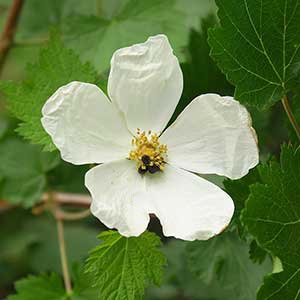Rubus bartonianus
Rubus repens
Barton's raspberry, bartonberry
dalibarde rampante, false violet, robin runaway
erect, sparsely short-hairy, glabrescent, eglandular, not pruinose.
creeping, moderately appressed-hairy, eglandular or sparsely to moderately stipitate-glandular, not pruinose.
deciduous, simple;
stipules lanceolate, 4–6 mm;
blade cordate to broadly ovate, (2–)2.5–4(–5) × (2.5–)3.5–4.5(–5.5) cm, base deeply cordate, 3–5-lobed, lobe apices acute to obtuse, margins coarsely doubly dentate, abaxial surfaces glabrous or sparsely hairy, eglandular or sparsely stipitate-glandular.
deciduous, simple;
stipules lanceolate-laciniate, (2–)3–5(–8) mm;
blade ovate-orbiculate, 1.5–2.7(–3) × 1.5–3.5(–4) cm, base deeply cordate, unlobed, margins crenate to broadly dentate, apex rounded, abaxial surfaces sparsely to moderately hairy, sparsely to moderately short-stipitate-glandular.
1-flowered.
1-flowered.
moderately hairy, eglandular or sparsely stipitate-glandular.
moderately and retrorsely long-hairy, eglandular.
bisexual;
petals white, obovate, (15–)20–25 mm;
filaments filiform;
ovaries glabrous, styles clavate, villous.
bisexual;
petals absent in fertile flowers, present in sterile flowers, white, narrowly elliptic to oblanceolate, 5–8 mm;
filaments filiform;
ovaries densely hairy, styles glabrous.
deep red, hemispheric, to 1 cm;
drupelets 10–30, coherent, separating from torus.
whitish, 0.3–0.5 cm, dry;
drupelets 5–10(–15), not coherent, separating from torus, enclosed by converging sepals.
= 14.
Rubus bartonianus
Rubus repens
Of conservation concern.
Rubus bartonianus is distinguished from the other flowering raspberries within its geographic range by its erect, unarmed stems, relatively small, simple leaves with acute to obtuse lobes, deeply cordate bases, sparsely hairy or glabrous abaxial surfaces, relatively large flowers with white petals, and densely long-hairy, clavate styles. The leaves superficially resemble those of Acer glabrum or some species of Ribes.
Rubus bartonianus is most similar to R. neomexicanus but especially R. deliciosus. The species is known only from the Snake River Canyon of Idaho and Oregon.
(Discussion copyrighted by Flora of North America; reprinted with permission.)
Rubus repens is recognized by its creeping, unarmed stems, simple, ovate-orbiculate leaves, long petioles with spreading hairs, sterile petaliferous flowers on long pedicels and fertile apetalous flowers on short pedicels, and essentially dry fruits. Phylogenetic analysis of DNA sequence data supports inclusion of D. repens in Rubus (L. A. Alice and C. S. Campbell 1999), among other basal species to R. lasiococcus (K. V. Ambrose 2006).
The Iroquois use a decoction of powdered plants of Rubus repens as a blood purifier and for venereal disease (J. W. Herrick 1977).
(Discussion copyrighted by Flora of North America; reprinted with permission.)


